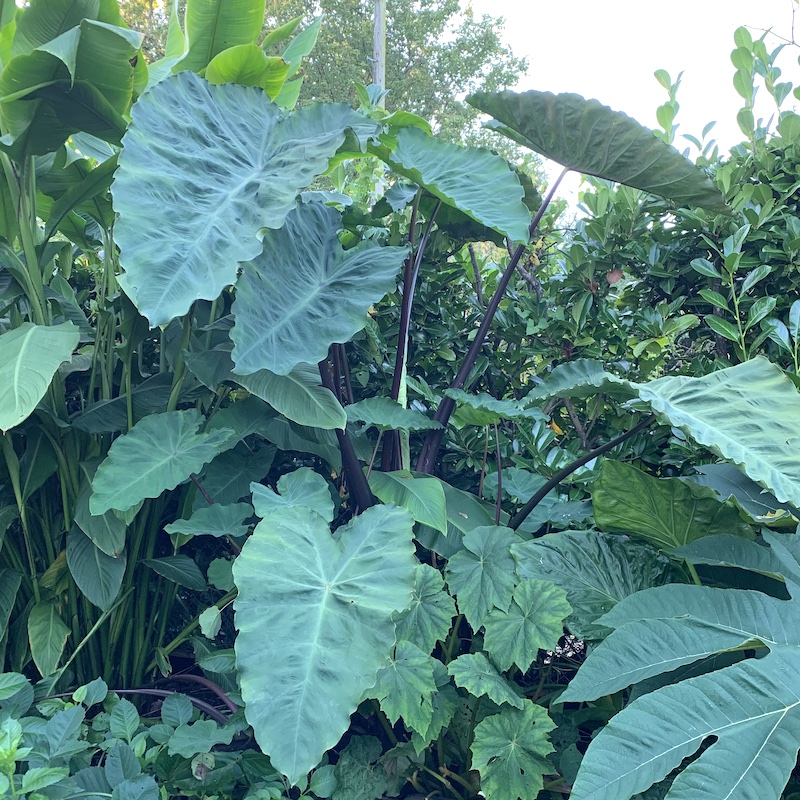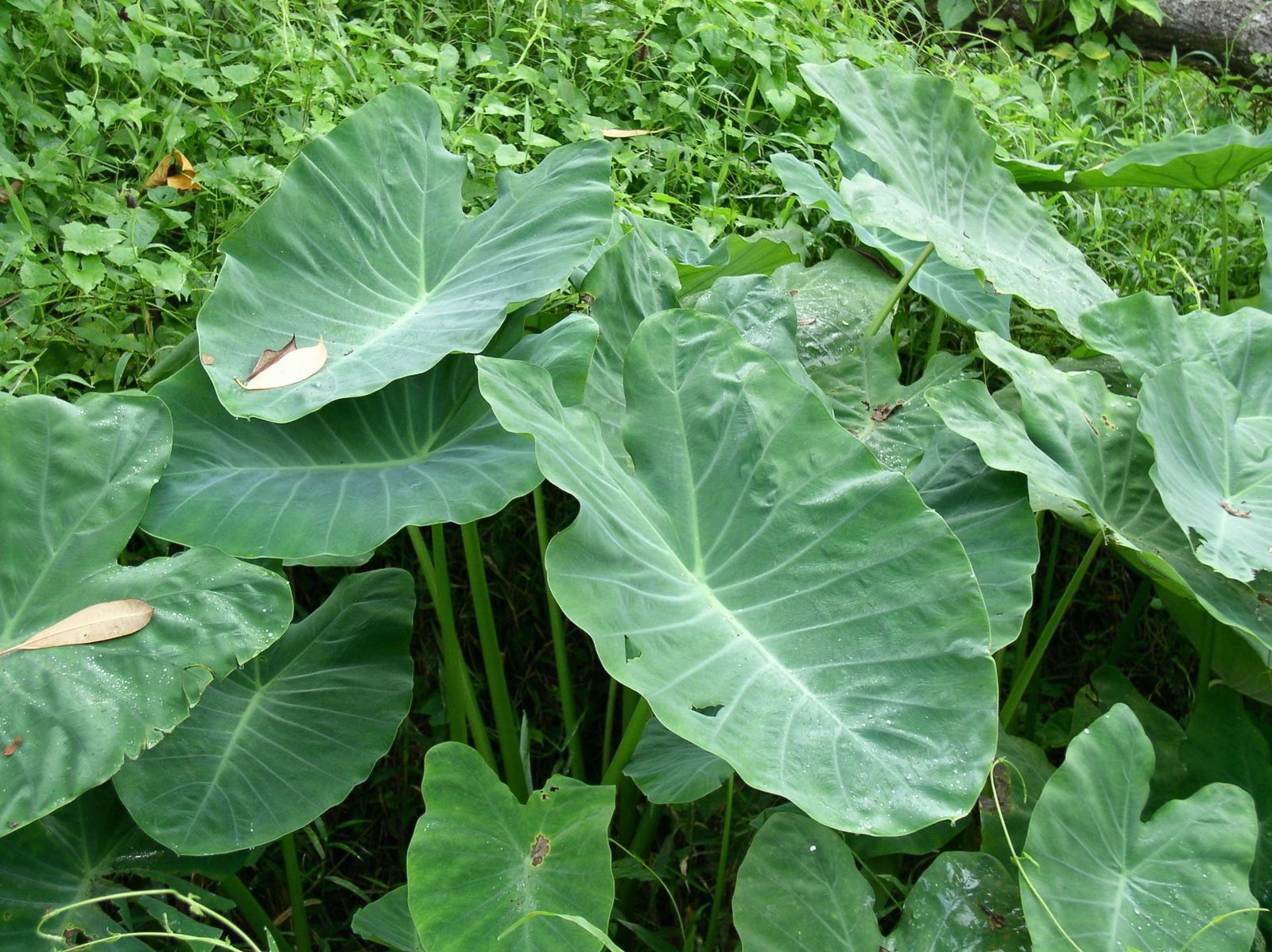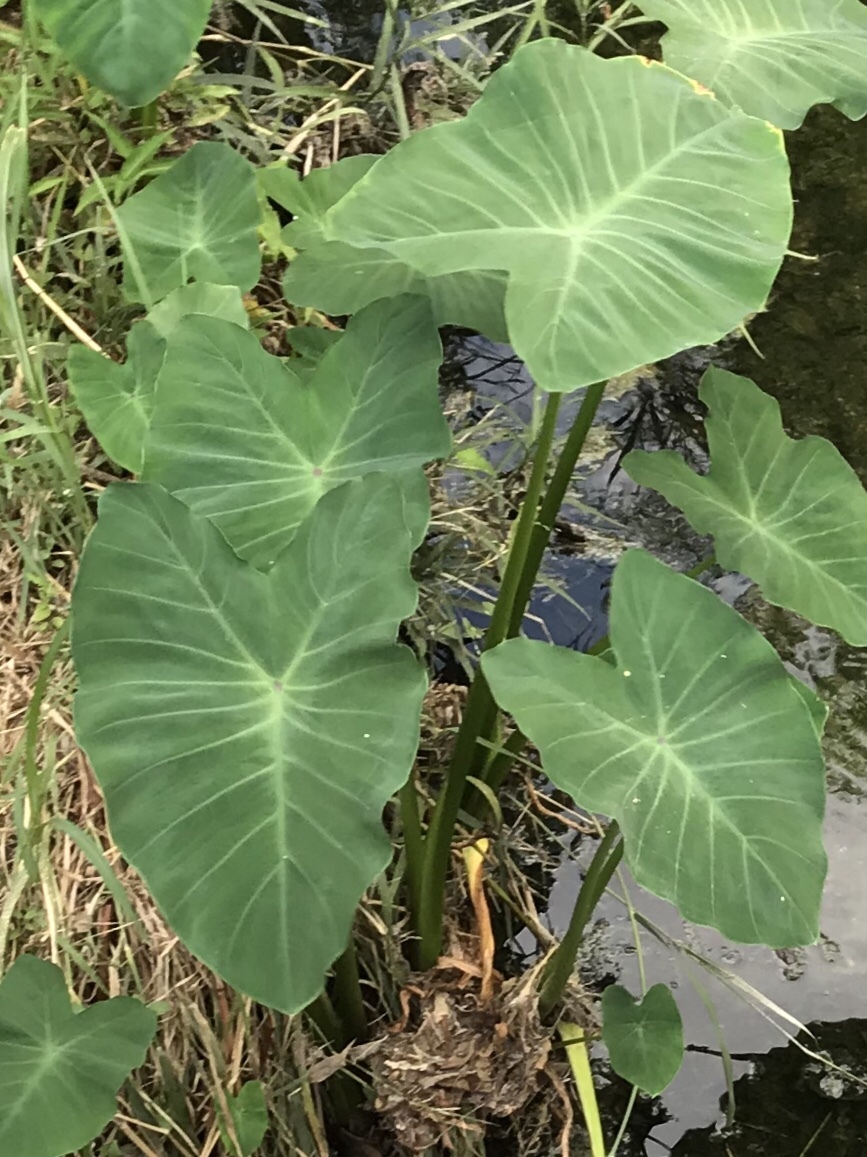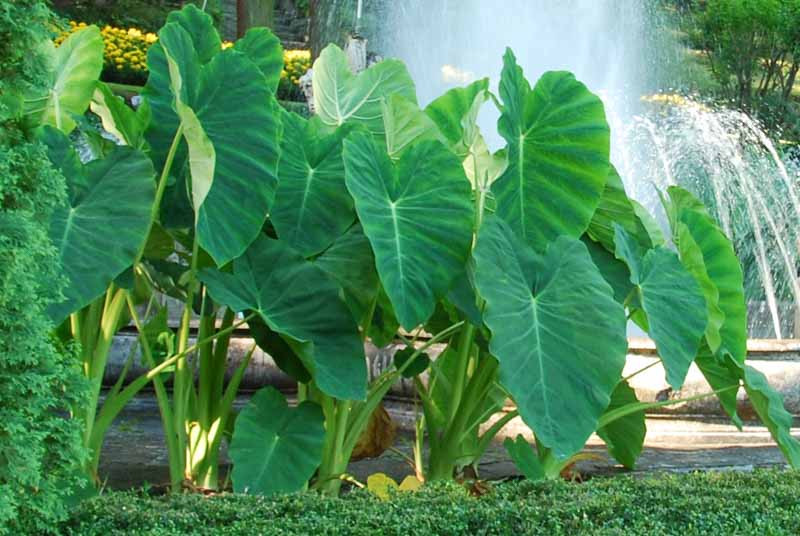The genus Colocasia, commonly known as taro, encompasses a diverse array of plants that have played a critical role in human societies for millennia. Native to Southeast Asia, these robust, striking plants have been cultivated for their edible corms, leaves, and even their stems, contributing significantly to both culinary traditions and cultural practices across the globe. This exploration delves into the fascinating world of Colocasia, highlighting three prominent species – Colocasia esculenta, Colocasia antiquorum, and Colocasia gigantea – unveiling their unique characteristics and the multifaceted ways they have shaped our world.

Colocasia esculenta: The Ubiquitous Taro
Known as the true taro, Colocasia esculenta is the most widely cultivated species within the genus. Its versatility shines through in its usage, with its starchy corm serving as a staple food in many tropical and subtropical regions. This incredibly adaptable plant thrives in a variety of environments, from the wet, humid conditions of Pacific islands to the drier, more temperate climates of South America. Its adaptability extends to its culinary applications, with its corm being boiled, roasted, steamed, or even fried, finding its way into dishes ranging from savory curries to sweet desserts. Colocasia esculenta boasts a multitude of cultivars, each showcasing unique characteristics and flavor profiles.
Cultivars of Colocasia esculenta
Dasheen
Dasheen is a variety of Colocasia esculenta that is widely cultivated in the Caribbean, Central America, and parts of Africa. It is known for its large, starchy corms that can reach up to 15 cm in diameter. Dasheen corms are typically boiled, roasted, or made into flour, and are a staple food in many communities.

Poi
Poi is a traditional Hawaiian dish made from the corms of Colocasia esculenta. The corms are boiled, pounded, and then fermented, resulting in a sticky, starch-rich paste that is a dietary staple in Hawaiian cuisine.
Malanga
Malanga is a variety of Colocasia esculenta that is primarily cultivated in the Caribbean and Latin America. It is known for its large, heart-shaped leaves and its starchy, nutty-flavored corms, which are often boiled, fried, or used in soups and stews.

Taro
Taro is the most widely recognized variety of Colocasia esculenta, and is cultivated throughout the world, particularly in Asia and the Pacific. Taro corms are starchy and slightly nutty in flavor, and can be prepared in a variety of ways, including boiling, roasting, and frying.

Culinary Uses of Colocasia esculenta
The versatility of Colocasia esculenta is evident in its wide-ranging culinary applications. The corms can be boiled, roasted, or steamed and served as a starchy vegetable, or they can be mashed and used as a thickener in soups and stews. The leaves of the plant are also edible and are commonly used in various cuisines, either cooked as a leafy green or wrapped around fillings to create a unique dish.
| Culinary Preparation | Flavor Profile |
|---|---|
| Boiled | Starchy, slightly nutty |
| Roasted | Crispy exterior, creamy interior |
| Steamed | Soft, delicate texture |
| Mashed | Smooth, creamy consistency |
| Leaves (cooked) | Earthy, slightly bitter |
In addition to being a staple food, Colocasia esculenta has also found its way into various cultural and religious practices around the world. In many Pacific Island cultures, the plant is revered for its spiritual and medicinal properties, and its leaves and corms are used in rituals and ceremonies.
Nutritional Benefits of Colocasia esculenta
Colocasia esculenta is a highly nutritious food source, providing a range of essential nutrients. The corms are rich in complex carbohydrates, fiber, and various vitamins and minerals, including:
- Carbohydrates
- Dietary fiber
- Vitamin C
- Vitamin B6
- Potassium
- Manganese
These nutrients make Colocasia esculenta a valuable addition to the diet, particularly in regions where it serves as a dietary staple.
Colocasia antiquorum: The Eddoe Taro
Colocasia antiquorum, also known as eddoe or Chinese taro, is a distinct species within the Colocasia genus. Unlike the ubiquitous Colocasia esculenta, Colocasia antiquorum is primarily cultivated in East and Southeast Asia, where it has been an integral part of the culinary and cultural landscape for centuries.
Characteristics of Colocasia antiquorum
Colocasia antiquorum is characterized by its smaller, more compact corms compared to Colocasia esculenta. These corms are typically oval-shaped and have a smooth, light-colored skin. The leaves of Colocasia antiquorum are also distinct, with a more rounded, arrow-shaped appearance.
Cultivars of Colocasia antiquorum
- Hong Kong Taro: A popular variety cultivated in Hong Kong and southern China, known for its creamy, slightly sweet flavor.
- Japanese Eddoe: A variety commonly grown in Japan, with a firm, starchy texture and a slightly nutty taste.
- Thai Eddoe: A variety found in Thailand, characterized by its small, elongated corms and slightly bitter flavor.
Culinary Uses of Colocasia antiquorum
Colocasia antiquorum is versatile in the kitchen, with its corms, leaves, and even stems finding their way into various regional cuisines. The corms are often boiled, steamed, or stir-fried, and can be used in soups, stews, and even desserts. The leaves are also commonly used in East and Southeast Asian dishes, either cooked as a leafy green or wrapped around fillings.
| Culinary Preparation | Flavor Profile |
|---|---|
| Boiled | Creamy, slightly sweet |
| Steamed | Firm, slightly nutty |
| Stir-fried | Crisp exterior, tender interior |
| Leaves (cooked) | Earthy, slightly bitter |
Nutritional Profile of Colocasia antiquorum
Like Colocasia esculenta, Colocasia antiquorum is a nutritious food source, providing a range of essential nutrients. The corms are rich in carbohydrates, fiber, and various vitamins and minerals, including:
- Carbohydrates
- Dietary fiber
- Vitamin C
- Vitamin B6
- Potassium
- Magnesium
These nutrients make Colocasia antiquorum a valuable addition to the diet, particularly in regions where it is a staple food.
Colocasia gigantea: The Giant Taro
Colocasia gigantea, commonly known as the giant taro or Thai elephant ear, is a remarkable species within the Colocasia genus. As its name suggests, Colocasia gigantea is distinguished by its towering, massive leaves that can grow up to 1.5 meters in length, dwarfing the more familiar Colocasia esculenta and Colocasia antiquorum.
Characteristics of Colocasia gigantea
Colocasia gigantea is a true visual spectacle, with its colossal leaves and sturdy, robust stems. The corms of Colocasia gigantea are also larger than those of its counterparts, often reaching up to 30 cm in diameter. The leaves of this species are deeply lobed and can vary in color from deep green to purplish-green, adding to their striking appearance.
Cultivars of Colocasia gigantea
- Thai Elephant Ear: A variety commonly found in Thailand, known for its massive leaves and slightly sweet, starchy corms.
- Philippine Giant Taro: A variety cultivated in the Philippines, with leaves that can grow up to 1.5 meters in length and a slightly bitter corm flavor.
- Malaysian Giant Taro: A variety found in Malaysia, characterized by its large, deeply lobed leaves and a more neutral flavor profile in its corms.
Culinary and Cultural Significance of Colocasia gigantea
While the massive size of Colocasia gigantea may initially seem daunting, this species has a rich culinary and cultural heritage, particularly in Southeast Asia. The corms are commonly boiled, steamed, or roasted and used in a variety of dishes, from savory curries to sweet desserts. The leaves are also highly prized, often used as wrappers for fillings or cooked as a leafy green.
| Culinary Preparation | Flavor Profile |
|---|---|
| Boiled | Starchy, slightly sweet |
| Steamed | Creamy, delicate texture |
| Roasted | Crisp exterior, soft interior |
| Leaves (cooked) | Earthy, slightly bitter |
Beyond its culinary applications, Colocasia gigantea has also held significant cultural importance in many Southeast Asian societies. In Thailand, the giant taro is revered for its symbolic association with fertility and prosperity, and its leaves are often used in religious ceremonies and festivals.
Nutritional Value of Colocasia gigantea
Colocasia gigantea, like its Colocasia counterparts, is a highly nutritious food source. The corms are rich in complex carbohydrates, fiber, and a range of essential vitamins and minerals, including:
- Carbohydrates
- Dietary fiber
- Vitamin C
- Vitamin B6
- Potassium
- Calcium
These nutrients make Colocasia gigantea a valuable addition to the diet, particularly in regions where it is a dietary staple.
Conclusion
The genus Colocasia, with its three prominent species – Colocasia esculenta, Colocasia antiquorum, and Colocasia gigantea – has played a pivotal role in shaping the culinary and cultural traditions of societies around the world. From the ubiquitous taro to the majestic giant taro, these versatile plants have adapted to a wide range of environments, providing sustenance and cultural significance to countless communities.
As we delve deeper into the world of Colocasia, we uncover a tapestry of culinary diversity, where the starchy corms, tender leaves, and even the stems of these plants are transformed into a myriad of dishes, each reflecting the unique flavors and traditions of the regions in which they are grown. Moreover, the cultural significance of Colocasia extends beyond the kitchen, with these plants serving as symbols of fertility, prosperity, and spiritual connection in many societies.
The enduring legacy of Colocasia serves as a testament to the remarkable adaptability and resilience of these plants, and their continued importance in the lives of people worldwide. As we navigate the ever-evolving culinary landscape, the rich history and diverse applications of Colocasia offer a window into the profound ways in which plants have shaped and continue to shape our world.
FAQs
- What are some popular Colocasia varieties?
Some popular Colocasia varieties include Colocasia esculenta (Taro), Colocasia gigantea (Giant Taro), Colocasia antiquorum (Eddoe), Colocasia ‘Black Coral’ (ornamental variety), and Colocasia ‘Mojito’ (ornamental variety).
- What are the differences between Colocasia esculenta and Colocasia antiquorum?
Colocasia esculenta (Taro) typically has larger corms with a milder flavor, while Colocasia antiquorum (Eddoe) has smaller corms with a slightly more pungent taste. Both are used in cooking, but Taro is more common in Southeast Asian cuisine, while Eddoe is more popular in the Caribbean.
- Are there ornamental Colocasia varieties?
Yes, there are many ornamental Colocasia varieties grown for their striking foliage. These varieties often have large, colorful leaves with unique patterns and textures. Examples include ‘Black Coral,’ ‘Mojito,’ ‘Illustris,’ and ‘Coffee Cups.’
- How do I choose the right Colocasia variety for my garden?
Consider your climate, available space, and intended use when choosing a Colocasia variety. Some varieties are more cold-hardy than others, while some are better suited for ornamental purposes than culinary use.
- Where can I buy Colocasia plants or corms?
Colocasia plants and corms can be purchased from nurseries, garden centers, online retailers, and even some farmers’ markets. Be sure to choose a reputable source to ensure you’re getting healthy plants or corms of the desired variety.


2 thoughts on “Varieties Colocasia”